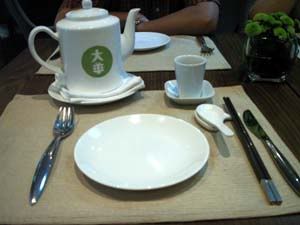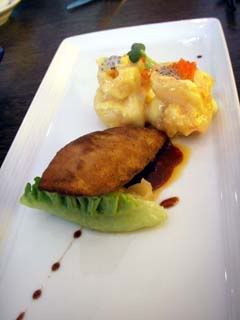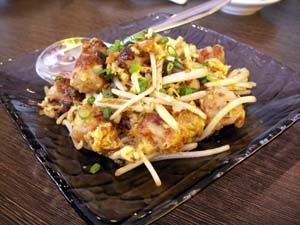The Stylish Gloss on Chinese Food
After a lunch of grazing on a few communal plates at The Majestic Chinese restaurant, I had some thoughts about modern Chinese food in Singapore today.
The idea of modern Chinese cuisine was initiated in Singapore by Club Chinois, Tung Lok Group of Restaurants. Nouvelle chinois cuisine painted a stylist gloss on Chinese food. Individual portions and stylish platings alongside a ‘fusion’ style of cooking incorporating ingredients from other cuisines that were traditionally not used in Chinese cuisine. More restaurants have taken on this label of modern Chinese, innovating and pushing the flavour boundaries. That, however, has also lead to a near duplication of some dishes, such as the now ubiquitious wasabi prawns.

Nouvelle chinois cuisine has also caused a minor revolution in Chinese restaurant décor. Forks and spoons were no longer just serving utensils, they made their way to the standard table setting alongside the soup spoon, chopsticks and the nifty holder that prevented them from making any contact with table. As Humble House, which was designed by Zhang Jin Jie, an established artist, Majestic Restaurant finds its home in the über chic restored Majestic hotel. The much talked about décor here and the swimming pool ceiling did not do much for me, but what I liked was the huge kitchen window that allows you to privy into the matters of the kitchen and to watch the cooks dancing to their own kitchen rhythm.
The food although elegant and delicious, read Chubby Hubby’s and colin's mouthwatering review here, lacked some sort of distinctive identity. My case in point is the foie gras and Peking duck skin pairing served with a wasabi prawn, which was a well executed combination of rich sweet flavours and crisp textures did not really offer any interesting interpretation. The strength of this restaurant lies in the mix of contemporary and classic offerings that can be paired and served without much confusion.

Foie Gras with Wasabi Prawns, Taste Paradise
Another modern Chinese restaurant that I have recently dined at is Taste Paradise, where I thought the food was excellent. We started off with a similar rendition of foie gras with wasabi prawns as the one in Majestic Restaurant, it was just as indulgent even without the extra silver of crispy Peking duck skin.

Homemade carrot cake, Taste Paradise
Our next plate was their signature homemade carrot cake. I don’t have a clue how Chef Fong made it, but its texture was exquisite—soft, smooth and slightly springy. I’ll agree with Wong Ah Yoke that to date the best plate of carrot cake I’ve had, and at that point in time, I was sure I was going to come back for more.
A plate of Thai-styled deep fried white bait arrived next. It was an interesting hybrid of a Thai mango salad and the conventional deep fried white bait served as a dim sum or appetiser in a Chinese meal. I liked this for its refreshing flavours and its play on the cold and hot crunchy elements on the plate.
From the meat department, we sampled the popular baked lamb rack in red wine and beef cubes cooked French style, which were tasty and tender. The only disappointment was very unfortunately the finishing bowl of homemade mee sua with seafood in superior broth that was too starchy. But other than, Taste Paradise offers some creative sounding and interesting tasting dishes, while others such as the homemade carrot cake in particular, are simple and refined that taste like paradise.
Majestic Restaurant
31-37 Bukit Pasoh Road
Tel: 65114718
Taste Paradise
48-49 Mosque Street
Tel: 62262959
The idea of modern Chinese cuisine was initiated in Singapore by Club Chinois, Tung Lok Group of Restaurants. Nouvelle chinois cuisine painted a stylist gloss on Chinese food. Individual portions and stylish platings alongside a ‘fusion’ style of cooking incorporating ingredients from other cuisines that were traditionally not used in Chinese cuisine. More restaurants have taken on this label of modern Chinese, innovating and pushing the flavour boundaries. That, however, has also lead to a near duplication of some dishes, such as the now ubiquitious wasabi prawns.

Nouvelle chinois cuisine has also caused a minor revolution in Chinese restaurant décor. Forks and spoons were no longer just serving utensils, they made their way to the standard table setting alongside the soup spoon, chopsticks and the nifty holder that prevented them from making any contact with table. As Humble House, which was designed by Zhang Jin Jie, an established artist, Majestic Restaurant finds its home in the über chic restored Majestic hotel. The much talked about décor here and the swimming pool ceiling did not do much for me, but what I liked was the huge kitchen window that allows you to privy into the matters of the kitchen and to watch the cooks dancing to their own kitchen rhythm.
The food although elegant and delicious, read Chubby Hubby’s and colin's mouthwatering review here, lacked some sort of distinctive identity. My case in point is the foie gras and Peking duck skin pairing served with a wasabi prawn, which was a well executed combination of rich sweet flavours and crisp textures did not really offer any interesting interpretation. The strength of this restaurant lies in the mix of contemporary and classic offerings that can be paired and served without much confusion.

Foie Gras with Wasabi Prawns, Taste Paradise
Another modern Chinese restaurant that I have recently dined at is Taste Paradise, where I thought the food was excellent. We started off with a similar rendition of foie gras with wasabi prawns as the one in Majestic Restaurant, it was just as indulgent even without the extra silver of crispy Peking duck skin.

Homemade carrot cake, Taste Paradise
Our next plate was their signature homemade carrot cake. I don’t have a clue how Chef Fong made it, but its texture was exquisite—soft, smooth and slightly springy. I’ll agree with Wong Ah Yoke that to date the best plate of carrot cake I’ve had, and at that point in time, I was sure I was going to come back for more.
A plate of Thai-styled deep fried white bait arrived next. It was an interesting hybrid of a Thai mango salad and the conventional deep fried white bait served as a dim sum or appetiser in a Chinese meal. I liked this for its refreshing flavours and its play on the cold and hot crunchy elements on the plate.
From the meat department, we sampled the popular baked lamb rack in red wine and beef cubes cooked French style, which were tasty and tender. The only disappointment was very unfortunately the finishing bowl of homemade mee sua with seafood in superior broth that was too starchy. But other than, Taste Paradise offers some creative sounding and interesting tasting dishes, while others such as the homemade carrot cake in particular, are simple and refined that taste like paradise.
Majestic Restaurant
31-37 Bukit Pasoh Road
Tel: 65114718
Taste Paradise
48-49 Mosque Street
Tel: 62262959
Labels: cantonese, majestic, modern chinese, taste paradise


6 Comments:
You're lucky. Umami and I didn't have such a good impression of Majestic:
http://food.recentrunes.com/?p=1311
Taste Paradise was good though:
http://food.recentrunes.com/?p=1084
I had quite good experiences at both places. I was served crab claws at majestic instead of the wasabi prawns. Taste paradise was quite good too but i didn't really like the desserts there but i must say prices do differ by quite a bit at both places.
It's quite true that somewhere along the route of desperately trying to be "modern" and "innovative", "identity" was lost.
Hmm.. i have never tasted fois gras before but i guess they are not cheap?
But its worth the try next time with my family... ")
You must be rather young to think that Modern Chinese started at Club Chinois. It is clear from your musing that you recognize the genre, but my oh my, to give you a chronology of where and when it started and how it got to where you think it started I will need to dust off my thinking cap and the archives on Singapore culinary history. I will get back to you..
@hcwong: It depends on the epoch that Joone is talking about. Club Chinois was amongst the first to elevate Chinese Fusion cuisine to Haute Cuisine in Singapore.
Tracing when Chinese Fusion started can be fun, but very complex as you need to decide on which dialect too. However, mostly you can start with the Colonies or Shanghai. ;)
Most of the time it is dependent upon availability of local ingredients and adaptability.
If you read the recipes left by the Singapore Masters like Tham Yu Kai, you will realize just how creative they were in using what was available.
For example, the Laksa in Singapore is different from the one in Penang and radically from the one in India.
Coming back to a slightly less pretentious note, here's my favourite fusion food:
http://food.recentrunes.com/?p=684
Post a Comment
Subscribe to Post Comments [Atom]
<< Home